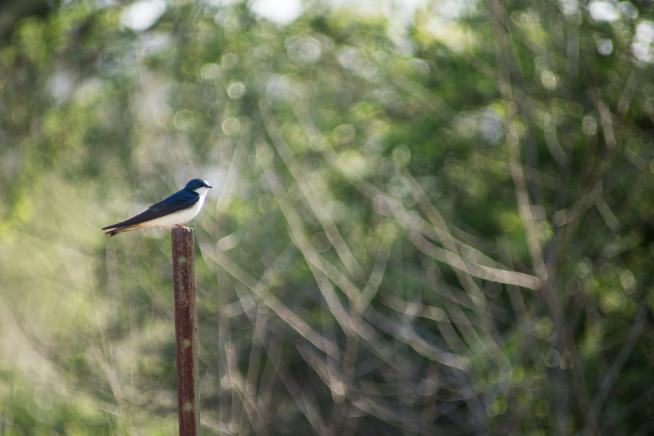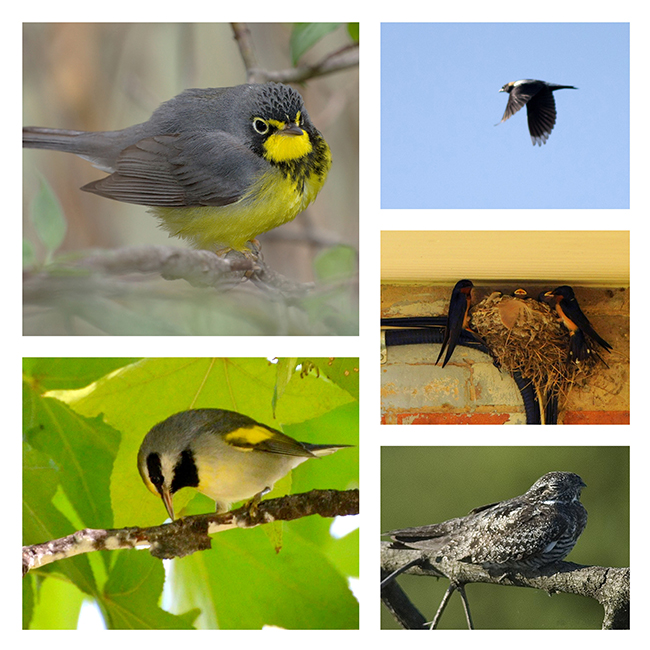2014 Ontario Bioblitz Bird Count Gets Results!

By guest blogger Kevin Kerr, Curator of Birds & Invertebrates at the Toronto Zoo, Taxon Lead for the 2014 Ontario Bioblitz Bird Team
On May 24th at 11:49 a.m., I watched in frustration as a Common Nighthawk flew across a flawless blue sky. Nighthawks are not hawks at all, but rather insectivorous birds of a family known as the Caprimulgidae (a name that roughly translates to “goatsucker” and derives from an ancient misconception regarding their diet). The name is doubly misleading since nighthawks are actually most active at dusk and dawn. To see one flying shortly before noon is just weird!
On an average day, a lunchtime cameo from a nighthawk would be a welcomed anomaly, but this day was different. I was positioned atop a verdant green hill with an army of taxonomic specialists all donning bright blue T-shirts. We were attending the opening ceremony for the 2014 Ontario BioBlitz and were patiently waiting for the clock to strike twelve so that our 24-hour count could begin. I was tasked with coordinating the bird team.
After watching it flying overhead for some time in its typical erratic flight pattern, pursuing flying insects, the nighthawk finally disappeared into the distance. I looked at my watch: 11:52 a.m. We couldn’t count it.

Selected bird species-at-risk in Ontario, clockwise, from upper left: Canada Warbler, Cardellina canadensis (Photo by William H. Majoros); Bobolink, Dolichonyx oryzivorus (Photo © Bronwyn Salmon, used with permission); Barn Swallows, Hirundo rustica (Photo by Brennan Caverhill); Common Nighthawk, Chordeiles minor (Photo by leppyone); Golden-winged Warbler, Vermivora chrysoptera (Photo by Andy Reago).
As luck would have it, my frustration would be short-lived, as we had no trouble locating Common Nighthawk later on in the day. Sighting this species was special because they are listed as a Species at Risk in Ontario, which means that they are sensitive to human activities and at risk of endangerment or even extirpation. In all, we would find nine bird species at risk on the BioBlitz (these included four species of special concern: Common Nighthawk, Olive-sided Flycatcher, and Golden-winged and Canada Warblers; four threatened species: Chimney Swift, Barn Swallow, Bobolink, and Eastern Meadowlark; and one endangered species: Acadian Flycatcher). The results speak volumes about the importance of the Humber River watershed.
Divided into just three small teams of bird enthusiasts, we managed to thoroughly cover eight protected areas, mostly comprised of Conservation Areas. The rich diversity of habitats, combined with help from a few other watchful eyes from other taxon groups allowed us to tally 120 different species of birds for the day. All-in-all it was a great success, lots of fun, and rarely frustrating.
The 2014 Ontario Bioblitz was the third annual Ontario Bioblitz, which took place from noon, May 24th until noon, May 25th in the Humber River watershed. What is a Bioblitz? It's a 24-hour intensive survey of all living organisms within a given area! The 2014 event saw the Royal Ontario Museum partner with seven other major organizations to coordinate roughly 500 volunteers in an effort to catalogue the biodiversity of the Humber River area. While the event itself is over, the identification of specimens continues; you can learn more about the rising species count from this year's Bioblitz here.
